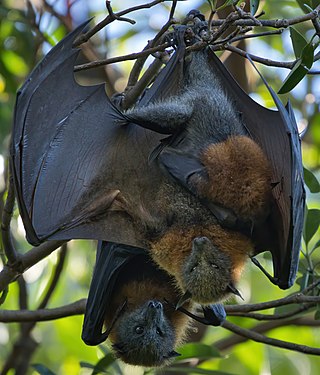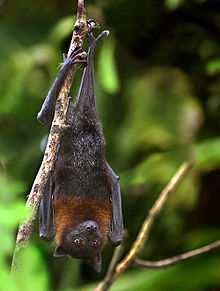
Megabats constitute the family Pteropodidae of the order Chiroptera (bats). They are also called fruit bats, Old World fruit bats, or—especially the genera Acerodon and Pteropus—flying foxes. They are the only member of the superfamily Pteropodoidea, which is one of two superfamilies in the suborder Yinpterochiroptera. Internal divisions of Pteropodidae have varied since subfamilies were first proposed in 1917. From three subfamilies in the 1917 classification, six are now recognized, along with various tribes. As of 2018, 197 species of megabat had been described.

The giant golden-crowned flying fox, also known as the golden-capped fruit bat, is a species of megabat endemic to the Philippines. Since its description in 1831, three subspecies of the giant golden-crowned flying fox have been recognized, one of which is extinct. The extinct subspecies was formerly recognized as a full species, the Panay golden-crowned flying fox. Formerly, this species was placed in the genus Pteropus; while it is no longer within the genus, it has many physical similarities to Pteropus megabats. It is one of the largest bat species in the world, weighing up to 1.4 kg (3.1 lb)—only the Indian and great flying fox can weigh more. It has the longest documented forearm length of any bat species at 21 cm (8.3 in).

Pteropus is a genus of megabats which are among the largest bats in the world. They are commonly known as fruit bats or flying foxes, among other colloquial names. They live in South Asia, Southeast Asia, Australia, East Africa, and some oceanic islands in the Indian and Pacific Oceans. There are at least 60 extant species in the genus.

The grey-headed flying fox is a megabat native to Australia. The species shares mainland Australia with three other members of the genus Pteropus: the little red P. scapulatus, spectacled P. conspicillatus, and the black P. alecto. The grey-headed flying fox is the largest bat in Australia.

The spectacled flying fox, also known as the spectacled fruit bat, is a megabat that lives in Australia's north-eastern regions of Queensland. It is also found in New Guinea and on the offshore islands including Woodlark Island, Alcester Island, Kiriwina, and Halmahera.

The black flying fox or black fruit bat is a bat in the family Pteropodidae. It is among the largest bats in the world, but is considerably smaller than the largest species in its genus, Pteropus. The black flying fox is native to Australia, Papua New Guinea, and Indonesia. It is not a threatened species.

Livingstone's fruit bat, also called the Comoro flying fox, is a megabat in the genus Pteropus. It is an Old World fruit bat found only in the Anjouan and Mohéli islands in the Union of the Comoros in the western Indian Ocean.

The wrinkle-lipped free-tailed bat is a species of bat in the family Molossidae. It is found in Bangladesh, Bhutan, Cambodia, China, Cocos (Keeling) Islands, India, Indonesia, Laos, Malaysia, Myanmar, Nepal, the Philippines, Sri Lanka, Thailand and Vietnam.

The Ryukyu flying fox or Ryukyu fruit bat is a species of megabat in the family Pteropodidae. It is found in Japan, Taiwan, and the Batanes and Babuyan Islands of the Philippines. Its natural habitats are subtropical or tropical dry forests and subtropical or tropical swamps. It is threatened by habitat loss and by hunting for food and the IUCN classify it as "Vulnerable".

The Indian flying fox, also known as the greater Indian fruit bat, is a species of flying fox native to the Indian subcontinent. It is one of the largest bats in the world. It is of interest as a disease vector, as it is capable of transmitting several viruses to humans. It is nocturnal and feeds mainly on ripe fruits, such as mangoes and bananas, and nectar. This species is often regarded as vermin due to its destructive tendencies towards fruit farms, but the benefits of its pollination and seed propagation often outweigh the impacts of its fruit consumption.

The small flying fox, island flying fox or variable flying fox is a species of flying fox in the family Pteropodidae. It is found in India, Indonesia, Malaysia, the Maldives, Myanmar, Papua New Guinea, the Philippines the Solomon Islands, Thailand and Vietnam.

The black-bearded flying fox is an endangered species of megabat in the genus Pteropus. It is endemic to Indonesia, found on the islands of Ambon, Buru, Seram, Banda, and Yamdena. Currently considered monotypic, it formerly included the Aru flying fox and Kei flying fox as subspecies.

The black-eared flying fox, species Pteropus melanotus, is a bat of the family Pteropodidae (megabats). Also known as Blyth's flying fox, it is found on the Andaman Islands and Nicobar Islands (India), and in Sumatra (Indonesia). A population on Christmas Island, which is critically endangered, has been placed as a subspecies of this population. The conservation and taxonomic status of that population was later re-established as a distinct species, the Christmas Island fruit-bat Pteropus natalis.

The great flying fox, also known as the greater flying fox or Bismarck flying fox, is a species of megabat in the genus Pteropus, found throughout lowland areas of New Guinea and in the Bismarck Archipelago. Conflicting evidence suggests that its closest relative is either the spectacled flying fox or, jointly, the Pelew and insular flying foxes. Two subspecies are recognized. At up to 1.6 kg (3.5 lb) in weight, it is among the heaviest bats in the world and the largest bat in Melanesia. It is a gregarious animal which roosts with hundreds or thousands of individuals. In part due to its wide variation in color, it has many taxonomic synonyms, including Pteropus degener, Pteropus papuanus, and Pteropus sepikensis. It may forage during the day or night in search of fruit, including figs or fruits from the family Sapotaceae. It is considered a least-concern species by the IUCN, though its numbers have been negatively impacted by what appeared to be a disease, as well as by hunting for bushmeat that occurs across its range.

The Rodrigues flying fox or Rodrigues fruit bat is a species of bat in the family Pteropodidae, the flying foxes or fruit bats. It is endemic to Rodrigues, an island in the Indian Ocean belonging to Mauritius. Its natural habitat is tropical lowland forests. The bats are sociable, roost in large groups during the day and feed at night, squeezing the juice and flesh out of fruits. They are hunted by humans for food and their numbers have been dwindling, and the International Union for Conservation of Nature has rated the species as being "endangered". In an effort to preserve them from extinction, some bats have been caught and are being bred in various zoos around the world.

The Madagascan flying fox, Madagascar flying-fox, or Madagascar fruit bat is a species of megabat in the genus Pteropus. It is endemic to Madagascar. Its natural habitats are diverse, and include moist lowland forests, dry forests, succulent woodlands, and spiny thickets, and mangroves. It eats figs and other fruits, flowers, and leaves. It is threatened by habitat loss.

The large flying fox, also known as the greater flying fox, Malayan flying fox, Malaysian flying fox, large fruit bat, kalang, or kalong, is a southeast Asian species of megabat in the family Pteropodidae. Despite its scientific name, it feeds exclusively on fruits, nectar, and flowers, like the other flying foxes of the genus Pteropus. It is noted for being one of the largest bats. As with nearly all other Old World fruit bats, it lacks the ability to echolocate but compensates for it with well-developed eyesight.

The Bougainville monkey-faced bat or Bougainville flying monkey is a megabat endemic to Bougainville Island of Papua New Guinea and Choiseul Island of the Solomon Islands in Melanesia. It inhabits mature forests in upland areas, within the Autonomous Region of Bougainville and Bougouriba Province.

The cave nectar bat, dawn bat, common dawn bat, common nectar bat or lesser dawn bat is a species of megabat within the genus Eonycteris. The scientific name of the species was first published by Dobson in 1871.

Bats as food are eaten by people in parts of some North American, Asian, African, Pacific Rim countries, and cultures, including the United States, China, Vietnam, Seychelles, the Philippines, Indonesia, Palau, Thailand, and Guam. Half the megabat species are hunted for food but only eight percent of the insectivorous bat species are. In Guam, Mariana fruit bats are considered a delicacy.






















